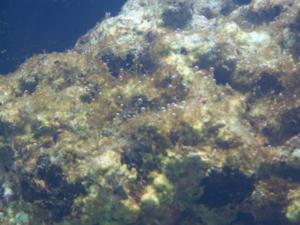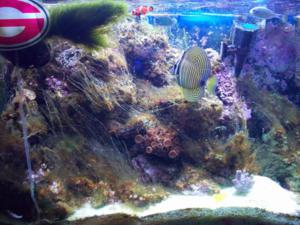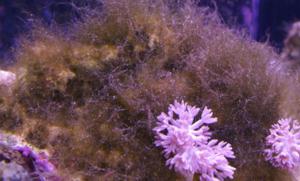I have a nano Macroalgae tank with a growing hair algae problem. Any tips?



Navigation
Install the app
How to install the app on iOS
Follow along with the video below to see how to install our site as a web app on your home screen.
Note: This feature may not be available in some browsers.
More options
You are using an out of date browser. It may not display this or other websites correctly.
You should upgrade or use an alternative browser.
You should upgrade or use an alternative browser.
Help with green hair algae?
- Thread starter charliedarling
- Start date
- Tagged users None
Get a robust CUC, including the operator.
I’ve got hermits, dove snails, trochus, turbo, cerith, marginella snails, they don’t seem to be able to keep up with it unfortunatelyGet a robust CUC, including the operator.
Thanks -Inverts will work well, but check your nitrates and phos too. And if u don’t have many corals lowering lights also work
Nitrates are 2.5ppm
Phosphate is .04ppm
I dose 1ml (about 2.5ppm worth) of neo nitro daily. Otherwise my macros go pale and start dying. Nitrates will bottom out in a few days if I don’t dose. I have 6 or 7 small corals in there and tried turning my lights down and the macros hated it, two days and a lot of them melted.
How old is the tank? I tend to notice hair algae problems when my tanks are newer (under 2-3 years old). If that's the case, just run some GFO until you don't need it anymore. Problems with adding too many invertebrates for me is that once the algae issue is fixed, most of them will starve to death which is kind of cruel imo.
Syphon out as much as you can use a tooth brush to scrub while syphoningI have a nano Macroalgae tank with a growing hair algae problem. Any tips?



And add a good CUC.
Syphoning is almost impossible; it’s a 5 gallon tank. By the time I get a siphon going half the waters gone lol xDSyphon out as much as you can use a tooth brush to scrub while syphoning
And add a good CUC.
Thanks for the info. It’s definitely a newer tank (4 months or so but I got it secondhand). I have some GFO but worried ill bottom out my phosphatesHow old is the tank? I tend to notice hair algae problems when my tanks are newer (under 2-3 years old). If that's the case, just run some GFO until you don't need it anymore. Problems with adding too many invertebrates for me is that once the algae issue is fixed, most of them will starve to death which is kind of cruel imo.
I never have an issue with it.
yes, new tank tend to run into these algae issues.sounds pretty normal to me. I never have an issue with GFO, if anything you can stop using it at any point.Thanks for the info. It’s definitely a newer tank (4 months or so but I got it secondhand). I have some GFO but worried ill bottom out my phosphates
Last edited:
Mine won’t eat gha, he scoots around eating any developing coraline. Had to get a pencil urchin too to take up his slack. That little guy is an algae eating machine…. Plus he doesn’t redecorate my tank tooTuxedo urchin is the star of my CUC. Consider getting one and they’re super cool little things
Very very interesting I’ll have to break out the microscope and throw some gfo in and see if that’ll wipe it out. Appreciate the insight. Maybe a dose of chemiclean and I’ll be able to get rid of it? If only life was that easy lol!That doesn't look like gha. Calothrix is def a possibility
There are quite a few differrrent variety of Cyanobacteria & GHA:
I don’t think you have Calothrix
 www.reefcleaners.org
www.reefcleaners.org

These species of cyano often appear as a light slimy yet hairy/fuzzy nastiness that loosely attaches to your rock work. Air bubbles are usually trapped while escaping the "algae", just like in the picture to the left. Calothrix is a type of blue green algae that looks very similar to Dinos. We have them next to each other in the guide to help you distinguish the difference between the two.
Manual Removal: Remove the rock and scrub, and then fine tune with a toothbrush. Let the cleaners get the rest. It helps to use a net to collect the debris that will occur as a result of the toothbrushing.
GHA


Green Hair Algae or "GHA" is really a broad term that covers hundreds of species of green simple filamentous algae. These species tend to be simple, fine in texture, and have few distinguishable features. True species level identification requires a microscope.
Distinguishing it from look-a-likes: GHA is not coarse or wiry, it should break apart easily when pulled, and should lose form quickly when removed from water. If you can make out a root structure, or a stiff branching structure it is probably not GHA
I don’t think you have Calothrix
Nuisance Algae ID Guide- Reef Cleaners
Nuisance Algae ID Guide. Red Slime, Cyano, Cyanobacteria. Green Film Algae, Film Algae. Green Hair Algae. Green Turf Algae. Bryopsis pennata and B. plumosa. Bubble Algae, Valonia. Lobophora. Blue Green Cyano.
Calothrix

These species of cyano often appear as a light slimy yet hairy/fuzzy nastiness that loosely attaches to your rock work. Air bubbles are usually trapped while escaping the "algae", just like in the picture to the left. Calothrix is a type of blue green algae that looks very similar to Dinos. We have them next to each other in the guide to help you distinguish the difference between the two.
Manual Removal: Remove the rock and scrub, and then fine tune with a toothbrush. Let the cleaners get the rest. It helps to use a net to collect the debris that will occur as a result of the toothbrushing.
GHA
Green Hair Algae


Green Hair Algae or "GHA" is really a broad term that covers hundreds of species of green simple filamentous algae. These species tend to be simple, fine in texture, and have few distinguishable features. True species level identification requires a microscope.
Distinguishing it from look-a-likes: GHA is not coarse or wiry, it should break apart easily when pulled, and should lose form quickly when removed from water. If you can make out a root structure, or a stiff branching structure it is probably not GHA
GHA is a macro algae.
Just as in my garden, I hand weed what I don’t want to see.
Just as in my garden, I hand weed what I don’t want to see.
Thanks, this is super informativeThere are quite a few differrrent variety of Cyanobacteria & GHA:
I don’t think you have Calothrix
Nuisance Algae ID Guide- Reef Cleaners
Nuisance Algae ID Guide. Red Slime, Cyano, Cyanobacteria. Green Film Algae, Film Algae. Green Hair Algae. Green Turf Algae. Bryopsis pennata and B. plumosa. Bubble Algae, Valonia. Lobophora. Blue Green Cyano.www.reefcleaners.org
Calothrix

These species of cyano often appear as a light slimy yet hairy/fuzzy nastiness that loosely attaches to your rock work. Air bubbles are usually trapped while escaping the "algae", just like in the picture to the left. Calothrix is a type of blue green algae that looks very similar to Dinos. We have them next to each other in the guide to help you distinguish the difference between the two.
Manual Removal: Remove the rock and scrub, and then fine tune with a toothbrush. Let the cleaners get the rest. It helps to use a net to collect the debris that will occur as a result of the toothbrushing.
GHA
Green Hair Algae


Green Hair Algae or "GHA" is really a broad term that covers hundreds of species of green simple filamentous algae. These species tend to be simple, fine in texture, and have few distinguishable features. True species level identification requires a microscope.
Distinguishing it from look-a-likes: GHA is not coarse or wiry, it should break apart easily when pulled, and should lose form quickly when removed from water. If you can make out a root structure, or a stiff branching structure it is probably not GHA
Here’s some more photos of what I’ve got going on. Certainly more “brown” than “green” but always assumed it was just GHA. I had a significant diatom bloom (microscope ID) and as soon as that subsided, this algae issue spread all over the tank. Some of the cells looked very algae like under the scope so that’s what I figured it was.There are quite a few differrrent variety of Cyanobacteria & GHA:
I don’t think you have Calothrix
Nuisance Algae ID Guide- Reef Cleaners
Nuisance Algae ID Guide. Red Slime, Cyano, Cyanobacteria. Green Film Algae, Film Algae. Green Hair Algae. Green Turf Algae. Bryopsis pennata and B. plumosa. Bubble Algae, Valonia. Lobophora. Blue Green Cyano.www.reefcleaners.org
Calothrix

These species of cyano often appear as a light slimy yet hairy/fuzzy nastiness that loosely attaches to your rock work. Air bubbles are usually trapped while escaping the "algae", just like in the picture to the left. Calothrix is a type of blue green algae that looks very similar to Dinos. We have them next to each other in the guide to help you distinguish the difference between the two.
Manual Removal: Remove the rock and scrub, and then fine tune with a toothbrush. Let the cleaners get the rest. It helps to use a net to collect the debris that will occur as a result of the toothbrushing.
GHA
Green Hair Algae


Green Hair Algae or "GHA" is really a broad term that covers hundreds of species of green simple filamentous algae. These species tend to be simple, fine in texture, and have few distinguishable features. True species level identification requires a microscope.
Distinguishing it from look-a-likes: GHA is not coarse or wiry, it should break apart easily when pulled, and should lose form quickly when removed from water. If you can make out a root structure, or a stiff branching structure it is probably not GHA
This growth is from only one week after scrubbing the rocks down *clean* in the sink, it’s explosive.
With such a small aquarium, you need to do a complete cleanup : RIP clean. Less than 2 hours work. Live rock with coral can be treated in a 10% solution of 3% h202 for 10 minutes, outside of tank. Remove all sand and flush with fresh water.
As a final thought, consider an Oxygenator system which uses hydrogen peroxide to manage system nuisance algae.
As a final thought, consider an Oxygenator system which uses hydrogen peroxide to manage system nuisance algae.
Similar threads
- Replies
- 10
- Views
- 229
- Replies
- 19
- Views
- 522
- Replies
- 3
- Views
- 144
- Replies
- 5
- Views
- 125


















